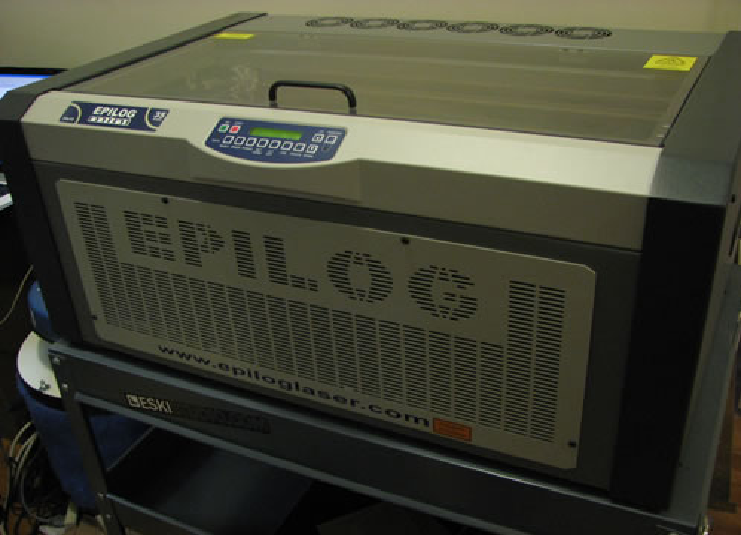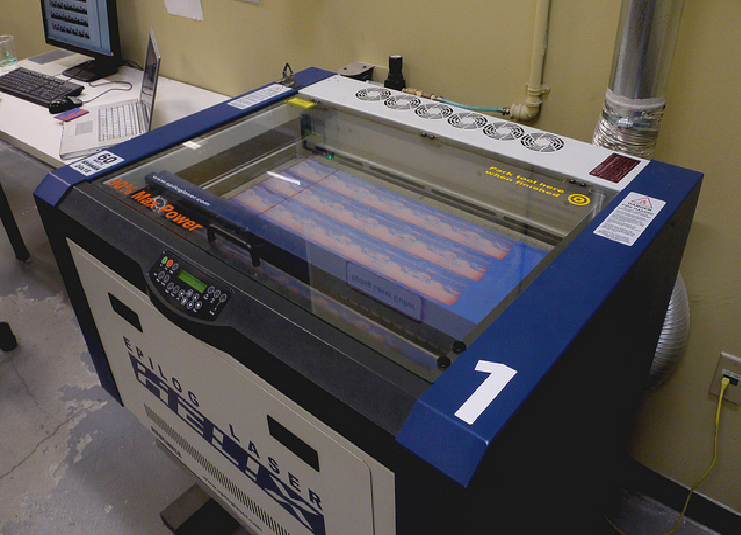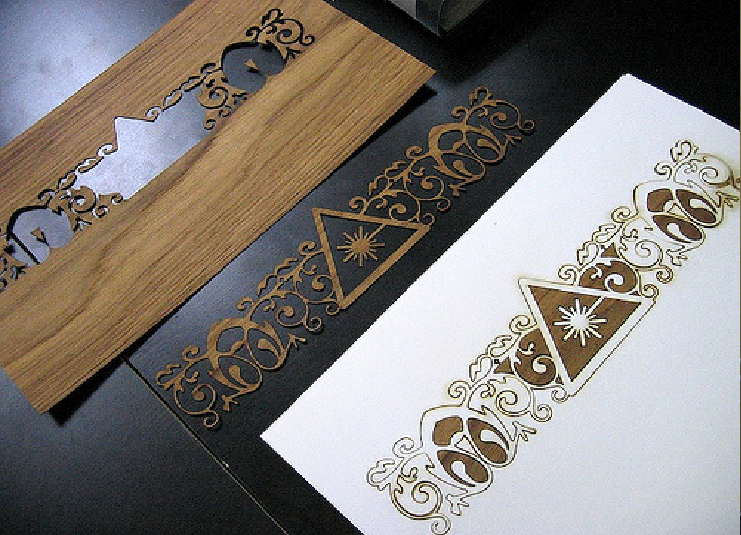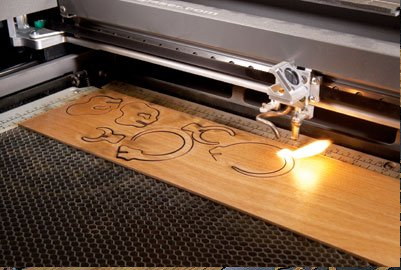Understanding Epilog Laser Cutting and Etching Lesson 1: Understanding the Machine
by OceanusEva in Workshop > Laser Cutting
8305 Views, 45 Favorites, 0 Comments
Understanding Epilog Laser Cutting and Etching Lesson 1: Understanding the Machine

Understanding Epilog C02 Laser Cutting and Etching Lesson 1: Understanding the Machine
Step 1: Introduction
Introduction
About Tech Shop
I made this at TechShop San Jose.
www.techshop.ws
I made this at TechShop San Jose (http://www.techshop.ws/). TechShop is a "build it yourself workshop" where members go to build their hopes and dreams. I joined TechShop San Jose to work on my business ideas and I have met a variety of passionate and hard-working characters. I implore you to check out their website if this sparks your curiosity!
Laser cutting has a variety of applications, some popular ones include etching wine glasses, etching awards, cutting signs, customizing personal objects (such as laptops), and fabric cutting. Those are just a few of the applications. The possibilities are limitless.
History of Laser Cutting
Laser cutting and etching is a technique used since 1965 and is very popular in the manufacturing world. There are three main lasers: CO2, neodymium (ND), and neodymium yttrium-aluminium garnet (Nd-YAG). A CO2 laser operates by emitting a gas mix (DC-exited method) or a radio frequency (RF-Exited method) to cut/etch the objects. Using radio frequency though a laser cutter is a new though increasingly popular method of cutting. CO2. Lasers use different techniques to cut/engrave objects. A laser microjet uses water to guide the laser beams. Different techniques produce different advantages to the mission you might be trying to complete.
The laser cutter I am using is called the Epilog CO2 laser cutter and has two different models of a 45 and a 60 Watt cutter. I am using a 60 watt cutter because that is the only one at the TechShop San Jose location at this time. The width of the tables at TechShop are 24"x18".
Safety
Harmful gasses and bright lights are both emitted from laser cutters. Although it is not required to wear eye protection or facial masks, a user could only benefit from wearing such protection. Facial masks are highly recommended when cutting any plastics. Remember safety first!
Depending on the speed and power the laser cutter is set at, small fires are potential problems too. If flames do appear during the cutting process, quickly turn off the printing process and proceed in the manor that best seems fit. A user should not leave the immediate proximity during the laser cut (unless another individual equally well knowledge in the machine looks after it while the user is away). If you must leave the work area, press the "Stop" button on the laser machine to pause the process to ensure safety while absent.
Materials Needed
https://www.instructables.com/id/Understanding-Epilog-Laser-Cutting-and-Etching-Les-1/
Step 1: Introduction
- About TechShop
- History Laser Cutting
- Laser Cutting Uses
- Safety
- Materials Needed
- Parts and There Functions
- Definitions
- Software
- Links To Other Useful Websites
- Link Tech Shop Again
- Link to Lesson 2
Introduction
About Tech Shop
I made this at TechShop San Jose.
www.techshop.ws
I made this at TechShop San Jose (http://www.techshop.ws/). TechShop is a "build it yourself workshop" where members go to build their hopes and dreams. I joined TechShop San Jose to work on my business ideas and I have met a variety of passionate and hard-working characters. I implore you to check out their website if this sparks your curiosity!
Laser cutting has a variety of applications, some popular ones include etching wine glasses, etching awards, cutting signs, customizing personal objects (such as laptops), and fabric cutting. Those are just a few of the applications. The possibilities are limitless.
History of Laser Cutting
Laser cutting and etching is a technique used since 1965 and is very popular in the manufacturing world. There are three main lasers: CO2, neodymium (ND), and neodymium yttrium-aluminium garnet (Nd-YAG). A CO2 laser operates by emitting a gas mix (DC-exited method) or a radio frequency (RF-Exited method) to cut/etch the objects. Using radio frequency though a laser cutter is a new though increasingly popular method of cutting. CO2. Lasers use different techniques to cut/engrave objects. A laser microjet uses water to guide the laser beams. Different techniques produce different advantages to the mission you might be trying to complete.
The laser cutter I am using is called the Epilog CO2 laser cutter and has two different models of a 45 and a 60 Watt cutter. I am using a 60 watt cutter because that is the only one at the TechShop San Jose location at this time. The width of the tables at TechShop are 24"x18".
Safety
Harmful gasses and bright lights are both emitted from laser cutters. Although it is not required to wear eye protection or facial masks, a user could only benefit from wearing such protection. Facial masks are highly recommended when cutting any plastics. Remember safety first!
Depending on the speed and power the laser cutter is set at, small fires are potential problems too. If flames do appear during the cutting process, quickly turn off the printing process and proceed in the manor that best seems fit. A user should not leave the immediate proximity during the laser cut (unless another individual equally well knowledge in the machine looks after it while the user is away). If you must leave the work area, press the "Stop" button on the laser machine to pause the process to ensure safety while absent.
Materials Needed
- A laser cutter
- Computer with correct program on it
- Materials needed to cut/engrave
https://www.instructables.com/id/Understanding-Epilog-Laser-Cutting-and-Etching-Les-1/
How Machine Works


#9: Turns the read beam on and off
#8: Press and then hit "GO" to move the X and Y axis to set your "HOME" positions. After you have set where you want the machine to refer to the place as home hit 7.
#7: Sets the home position
#6: Press to adjust and focus the machine. Press the up and down arrows for the palate to move us and down. After you get it where you would like press 0 (reset)
#5: Jobs
#4: Controls the Power
#3: Controls the speed
#0: Says reset though it just brings it to the beginning.
Only will take Corel X5 or illustrator program.
To start a program you have to go through a process, a user can not just press "start". The first thing to press is "9", this will turn the red light on. Then you press "8" and then "go" to disable the x and y axis. You will move the laser around to where you would like the home position to be. After that press "7" to enter the home position in. Press "6" now to focus the machine. You can press the up and down arrows to move the palate up and down. Once you have focused it correctly press "0". This will prepare everything. You are now ready to start laser cutting. Be sure to lower the plastic cover and press "go"!
#8: Press and then hit "GO" to move the X and Y axis to set your "HOME" positions. After you have set where you want the machine to refer to the place as home hit 7.
#7: Sets the home position
#6: Press to adjust and focus the machine. Press the up and down arrows for the palate to move us and down. After you get it where you would like press 0 (reset)
#5: Jobs
#4: Controls the Power
#3: Controls the speed
#0: Says reset though it just brings it to the beginning.
Only will take Corel X5 or illustrator program.
To start a program you have to go through a process, a user can not just press "start". The first thing to press is "9", this will turn the red light on. Then you press "8" and then "go" to disable the x and y axis. You will move the laser around to where you would like the home position to be. After that press "7" to enter the home position in. Press "6" now to focus the machine. You can press the up and down arrows to move the palate up and down. Once you have focused it correctly press "0". This will prepare everything. You are now ready to start laser cutting. Be sure to lower the plastic cover and press "go"!
Conclusion

Conclustion
LINK TO LESSON 2: UNDERSTANDING THE COMPUTER PRINTING OPTIONS
https://www.instructables.com/id/Understanding-Epilog-Laser-Cutting-and-Etching-Les-1/
TechShop:http://www.techshop.ws/
Links related to lasercutting: www.instructables.com, www.laserbits.com, www.epiloglaser.com/tech_library.htm
Authors email: Cooperevam@yahoo.com
If you would like more information or would be interested in hiring me to complete a project for you please email me at cooperevam@yahoo.com. I participate in freelance work so if you would like something etched or cut then email me with information and I should get back to you within 24 hours! Laser cutting and etching can be a cool inexpensive way to personalize a gift for a loved one or a friend. I also do the following services: embroidery services, 3D printing services, and designing in Autodesk Inventor 2013.
LINK TO LESSON 2: UNDERSTANDING THE COMPUTER PRINTING OPTIONS
https://www.instructables.com/id/Understanding-Epilog-Laser-Cutting-and-Etching-Les-1/
TechShop:http://www.techshop.ws/
Links related to lasercutting: www.instructables.com, www.laserbits.com, www.epiloglaser.com/tech_library.htm
Authors email: Cooperevam@yahoo.com
If you would like more information or would be interested in hiring me to complete a project for you please email me at cooperevam@yahoo.com. I participate in freelance work so if you would like something etched or cut then email me with information and I should get back to you within 24 hours! Laser cutting and etching can be a cool inexpensive way to personalize a gift for a loved one or a friend. I also do the following services: embroidery services, 3D printing services, and designing in Autodesk Inventor 2013.